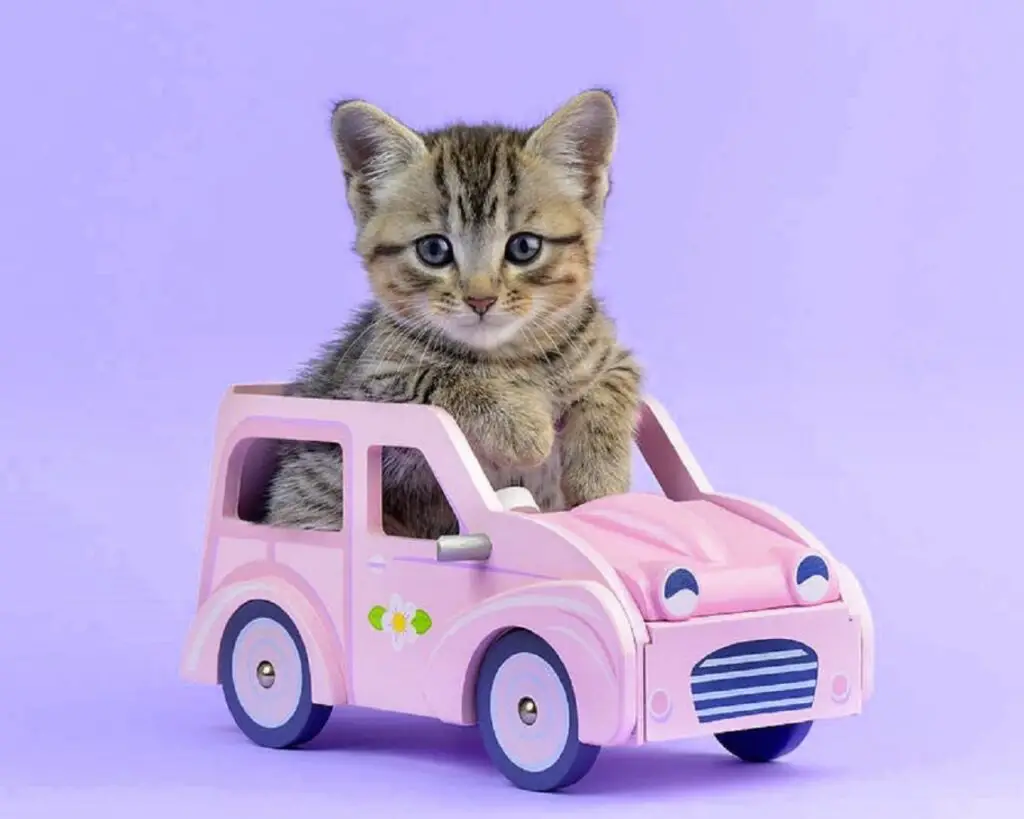Introduction
How To Travel With A Cat In A Car: Traveling with a cat in a car can be a challenging experience for both the cat and the owner. Cats are known for their independent nature and can become easily stressed or anxious when taken out of their familiar environment. However, with proper preparation and care, it is possible to make car travel a more comfortable and enjoyable experience for your feline friend.
Firstly, it is important to ensure that your cat is comfortable and secure during the journey. This can be achieved by providing a suitable carrier or crate for your cat to travel in. The carrier should be well-ventilated and large enough for your cat to stand, turn around, and lie down comfortably. It is also recommended to line the carrier with a soft blanket or towel to provide additional comfort.
Secondly, it is essential to acclimate your cat eat to the carrier before the trip. Cats are creatures of habit and may feel anxious or scared if they are suddenly placed in an unfamiliar carrier. To help your cat become more comfortable with the carrier, leave it open in your home for a few days before the trip. Encourage your cat to explore the carrier by placing treats or toys inside. Gradually increase the amount of time your cat spends in the carrier, starting with short periods and gradually extending the duration.
Additionally, it is important to consider your cat’s safety during the car journey. Cats should never be allowed to roam freely in the car as they can easily become a distraction to the driver or get injured in the event of sudden braking or an accident. Always secure the carrier with a seatbelt or place it in a well-ventilated area of the car where it will not be jostled or tipped over. It is also advisable to avoid opening car windows too wide to prevent your cat from escaping or getting injured.

How do you travel long distance with a cat in the car?
TIPS TO TRAVEL LONG DISTANCE WITH A CAT
- Choose the right carrier.
- Introduce kitty to their carrier early.
- Plan your journey in advance.
- Use a harness and lead for extra safety.
- Have your kitty microchipped.
- Bring a litter tray.
- Don’t feed your kitty as you leave!
- Consider your destination.
Traveling long distances with a cat in the car can be a challenging task. Cats are known for their dislike of change and unfamiliar environments, so it’s important to take certain precautions to ensure their comfort and safety during the journey. Whether you’re moving to a new home or going on a road trip, here are some tips to help you travel long distance with a cat in the car.
Prepare the cat carrier: Before embarking on your journey, make sure you have a suitable cat carrier that is secure and comfortable. Choose a carrier that is well-ventilated and large enough for your cat to stand, turn around, and lie down in. Line the carrier with a soft blanket or towel to provide extra comfort.
Introduce the carrier: If your cat is not accustomed to being in a carrier, it’s important to introduce them to it gradually. Leave the carrier open in your home and place treats, toys, or familiar bedding inside to encourage your cat to explore and associate positive experiences with the carrier.
Secure the carrier: Once your cat is comfortable with the carrier, secure it properly in the car. Place the carrier on the floor of the backseat or in the footwell of the front passenger seat. Use a seatbelt or secure the carrier with a bungee cord to prevent it from sliding or tipping over during the journey.
Make the carrier cozy: To make the carrier more inviting, place a familiar blanket or clothing item with your scent inside. This will help your cat feel more secure and relaxed during the journey. You can also consider using a pheromone spray or diffuser to create a calming environment for your cat.
How long can a cat travel in a car?
While a crate is a great option for shorter road trips, it’s not ideal for a trip longer than six hours. Your cat needs access to water and litter, and anything more than six hours is a bit unfair.
A cat can travel in a car for varying lengths of time depending on several factors. These factors include the cat’s temperament, previous experience with car travel, and the purpose of the car journey. Some cats may be more comfortable and relaxed in a car, while others may become stressed or anxious.
It is important to note that cats are generally not fond of car travel. They are creatures of habit and prefer familiar environments. However, with proper preparation and care, it is possible for a cat to travel in a car for short to moderate distances.
When planning a car journey with a cat, it is essential to ensure their safety and well-being. This includes using a secure carrier or crate to prevent the cat from roaming freely in the car. The carrier should be well-ventilated and comfortable, with familiar bedding and toys to provide a sense of security.
Additionally, it is advisable to acclimate the cat to the carrier and car travel gradually. This can be done by introducing the carrier as a positive and safe space in the cat’s daily routine. Gradually increase the duration of time spent in the carrier and take short practice drives to help the cat become accustomed to the motion and sounds of the car.
The length of time a cat can travel in a car also depends on the purpose of the journey. If it is a short trip to the veterinarian or a grooming appointment, the cat may only need to travel for a few minutes to an hour. However, if it is a longer journey, such as a cross-country move, it is important to plan for frequent breaks to allow the cat to stretch, use the litter box, and have access to food and water.
Are cats OK to travel in a car?
Start young: Kittens usually adjust to new experiences and surroundings more easily than an adult or senior cats, so start the travel-training process as early as possible. If your cat is past kittenhood, don’t worry: Adult and senior cats can still learn to tolerate car rides.
Yes, cats can travel in a car, but it is important to take certain precautions to ensure their safety and comfort during the journey. Cats are generally not fond of traveling and may experience stress and anxiety when taken out of their familiar environment. However, with proper planning and preparation, you can make car travel a more pleasant experience for your feline friend.
Firstly, it is essential to have a suitable carrier for your cat. A carrier provides a secure and confined space for your cat to travel in, preventing them from roaming freely inside the car. Make sure the carrier is well-ventilated and comfortable, with enough room for your cat to stand, turn around, and lie down. Line the carrier with a soft blanket or towel to provide additional comfort.
Secondly, it is important to acclimate your cat to the carrier before the trip. Leave the carrier open in your home and encourage your cat to explore and spend time inside it. Place treats and toys inside the carrier to create positive associations. Gradually increase the duration of time your cat spends in the carrier, making it a familiar and safe space for them.
Thirdly, it is crucial to secure the carrier inside the car. Place the carrier on the floor of the backseat or in the footwell of the front passenger seat. Use a seatbelt or a specially designed carrier restraint system to prevent the carrier from sliding or tipping over during sudden stops or turns. This will ensure your cat’s safety and prevent any potential injuries.
Additionally, it is important to make the car environment comfortable for your cat. Keep the temperature inside the car moderate and avoid exposing your cat to extreme heat or cold. Play soothing music or use pheromone sprays designed for cats to create a calming atmosphere. Avoid opening the windows too wide to prevent your cat from escaping or getting injured.
How do you transport a cat in a car?
You might consider a Shoulder Sling Pet Carrier or Backpack Pet Carrier. You can wear it when you’re out and about, but it also buckles into your car while you’re driving. Once you pick the “purrrfect” carrier, give your cat a chance to get used to it.
Transporting a cat in a car can be a challenging task, especially if your feline friend is not accustomed to car rides. However, with proper preparation and a few essential supplies, you can ensure a safe and comfortable journey for both you and your cat.
First and foremost, it is crucial to have a suitable carrier for your cat. A carrier provides a secure and confined space for your cat during the car ride, preventing them from roaming around and potentially causing distractions or accidents. Make sure the carrier is well-ventilated and large enough for your cat to stand, turn around, and lie down comfortably.
Before the car ride, it is essential to acclimate your cat to the carrier. Place the carrier in your home and encourage your cat to explore it by leaving treats or toys inside. Gradually increase the amount of time your cat spends in the carrier, making it a positive and familiar space for them. This will help reduce anxiety and stress during the car ride.
When it’s time to transport your cat, ensure their safety by securing the carrier in the car. Place the carrier on the back seat or in the footwell, using a seatbelt or a carrier restraint system to prevent it from sliding or tipping over. Avoid placing the carrier in the front seat or on your lap, as this can be dangerous for both you and your cat.
During the car ride, it is important to keep your cat calm and comfortable. Play soothing music or use pheromone sprays designed for cats to create a calming environment. Avoid sudden movements or loud noises that may startle your cat. If your cat shows signs of distress, such as excessive meowing or panting, pull over safely and provide reassurance.
How can I calm my cat down in the car?
How to Keep Your Cat Calm During Car Rides
- Tire Them Out Before You Leave. A tired pet is a calm pet.
- Take Short Test Drives.
- Bring Along a Familiar Smell.
- Have Lots of Treats Handy.
- Support Your Cat’s Health Inside and Out at Feline Medical Clinic.
Traveling with a cat can be a stressful experience, especially when it comes to car rides. Cats are known for their dislike of being confined and their tendency to become anxious in unfamiliar environments. However, there are several strategies you can try to help calm your cat down in the car and make the journey more pleasant for both of you.
1. Familiarize your cat with the car: Before embarking on a long car ride, it’s important to get your cat comfortable with the car itself. Start by allowing your cat to explore the car while it’s parked in a safe and quiet location. Let them sniff around and get used to the smells and sounds of the car. You can also try feeding your cat in the car or providing treats and toys to create positive associations.
2. Use a carrier: A carrier provides a secure and confined space for your cat during the car ride. Make sure the carrier is well-ventilated and comfortable with a soft bedding. Place familiar items, such as a blanket or a piece of clothing with your scent, inside the carrier to provide a sense of security. Additionally, cover the carrier with a towel or a blanket to create a cozy and den-like environment.
3. Gradual exposure: If your cat is particularly anxious in the car, it may be helpful to gradually expose them to short car rides. Start by taking your cat on short trips around the block and gradually increase the duration of the rides. This will help your cat become more accustomed to the motion and sounds of the car, reducing their anxiety over time.
4. Calming aids: There are various calming aids available that can help reduce your cat’s anxiety during car rides. These include pheromone sprays, which mimic the natural calming scents produced by cats, and calming supplements or treats that contain ingredients like chamomile or valerian root. Consult with your veterinarian to determine the most suitable calming aid for your cat.
5. Minimize stressors: To create a calm and soothing environment in the car, it’s important to minimize stressors as much as possible. Keep the car temperature comfortable and avoid loud music or sudden noises. Additionally, try to maintain a smooth and steady driving style to minimize the motion that can trigger your cat’s anxiety.
1. Use a secure carrier: It is essential to have a sturdy and well-ventilated carrier for your cat. Make sure it is large enough for them to stand, turn around, and lie down comfortably. Secure the carrier with a seatbelt or place it on the floor of the car to prevent it from sliding around during the journey.
2. Familiarize your cat with the carrier: Before the trip, introduce your cat to the carrier by leaving it open in your home with a cozy blanket and some treats inside. Encourage your cat to explore and spend time in the carrier, making it a positive and familiar space for them.
3. Gradually acclimate your cat to car travel: Start by taking short trips around the block to help your cat get used to the motion and sounds of the car. Gradually increase the duration of the trips to help them build tolerance and reduce anxiety. Offer treats and praise to create positive associations with car travel.
Are there any specific safety precautions to take when traveling with a cat in a car?
When traveling with a cat in a car, it is important to prioritize their safety to ensure a smooth and stress-free journey. One of the first safety precautions to take is to secure your cat in a carrier or crate. This will prevent them from roaming freely in the car and potentially causing distractions or getting injured in case of sudden stops or accidents. Make sure the carrier is well-ventilated and comfortable for your cat, with enough space for them to stand, turn around, and lie down.
Another important safety measure is to never leave your cat unattended in a parked car. Even with the windows cracked open, the temperature inside a car can rise quickly, leading to heatstroke or dehydration. If you need to leave the car, take your cat with you or find a pet-friendly place where they can stay comfortably. Additionally, it is advisable to use a harness and leash when taking your cat out of the car, as this will prevent them from escaping or getting lost in unfamiliar surroundings.
How can I make my cat feel more comfortable during car travel?
Traveling in a car can be a stressful experience for cats, but there are several things you can do to help make them feel more comfortable. First and foremost, it’s important to create a safe and secure environment for your cat in the car. This can be achieved by using a sturdy and well-ventilated carrier that is large enough for your cat to stand, turn around, and lie down in. Make sure to secure the carrier with a seatbelt or other restraints to prevent it from sliding or tipping over during the journey.
Additionally, you can help your cat feel more at ease by familiarizing them with the carrier before the trip. Leave the carrier open in your home with a soft blanket or bedding inside, and encourage your cat to explore and spend time in it. You can also try placing treats or toys inside the carrier to create positive associations. Gradually increase the amount of time your cat spends in the carrier, and reward them with praise and treats for calm behavior.
Are there any recommended products or accessories for traveling with a cat in a car?
When it comes to traveling with a cat in a car, there are several recommended products and accessories that can help make the journey more comfortable and safe for your feline friend. One essential item is a sturdy and secure cat carrier. Look for a carrier that is well-ventilated and has a secure latch or locking mechanism to prevent your cat from escaping during the ride. It’s also a good idea to choose a carrier that is easy to clean in case of any accidents or spills.
Another useful accessory for car travel with a cat is a harness and leash. While it may not be necessary for every cat, some felines may feel more secure and less anxious if they are able to explore their surroundings on a leash during rest stops. However, it’s important to note that not all cats will tolerate a harness, so it’s best to introduce it gradually and ensure your cat is comfortable before attempting to use it during car travel.
In addition to a carrier and harness, there are also products available specifically designed to reduce stress and anxiety in cats during car travel. These can include calming sprays or pheromone diffusers that emit soothing scents to help relax your cat. There are also natural supplements or medications that can be prescribed by a veterinarian to help alleviate anxiety. It’s always a good idea to consult with your vet before using any calming products or medications to ensure they are safe and appropriate for your cat.
What are some common challenges or issues that may arise when traveling with a cat in a car, and how can they be addressed?
Traveling with a cat in a car can present a variety of challenges and issues. One common challenge is motion sickness. Cats, like humans, can experience nausea and discomfort when traveling in a moving vehicle. To address this issue, it is important to gradually acclimate your cat to car rides. Start with short trips and gradually increase the duration. Additionally, avoid feeding your cat right before a car ride and provide plenty of fresh air by cracking a window or using the car’s air conditioning.
Another challenge that may arise is anxiety or stress. Cats are creatures of habit and can become anxious when faced with unfamiliar environments. To help alleviate this issue, create a comfortable and familiar space for your cat in the car. Use a secure carrier or harness to keep your cat safe and provide familiar bedding or toys to help them feel more at ease. Additionally, consider using calming pheromone sprays or treats to help reduce anxiety during the journey.

Conclusion
Traveling with a cat in a car can be a challenging experience, but with the right preparation and precautions, it can also be a safe and enjoyable journey for both you and your feline friend. By following a few simple guidelines, such as using a secure carrier, providing comfort and familiar items, and planning for breaks and rest stops, you can ensure a smooth and stress-free trip.
First and foremost, it is essential to use a secure carrier to transport your cat car. This will not only keep your cat safe but also prevent any distractions or accidents while driving. Make sure the carrier is well-ventilated and large enough for your cat to stand, turn around, and lie down comfortably. It is also a good idea to line the carrier with a soft blanket or towel to provide extra comfort and absorb any accidents.
Additionally, it is important to create a familiar and comfortable environment for your cat during the car journey. Bring along their favorite toys, blankets, and even a piece of clothing with your scent to help them feel secure and at ease. You can also consider using pheromone sprays or calming aids specifically designed for cats to help reduce anxiety and stress.
Lastly, remember to plan for breaks and rest stops along the way. Cats may need to use the litter box, stretch their legs, or have a drink of water. It is recommended to stop every few hours to allow your cat to take a break and attend to their needs. However, always make sure to keep your cat securely in their carrier or on a leash during these stops to prevent any potential escapes or accidents.
Traveling with a cat in a car requires careful planning and consideration. By using a secure carrier, providing comfort and familiar items, and planning for breaks and rest stops, you can ensure a safe and stress-free journey for both you and your feline companion. Remember to always prioritize your cat’s safety and well-being, and consult with a veterinarian if you have any specific concerns or questions. With the right preparation, traveling with your cat can be a rewarding and enjoyable experience.





No Comments